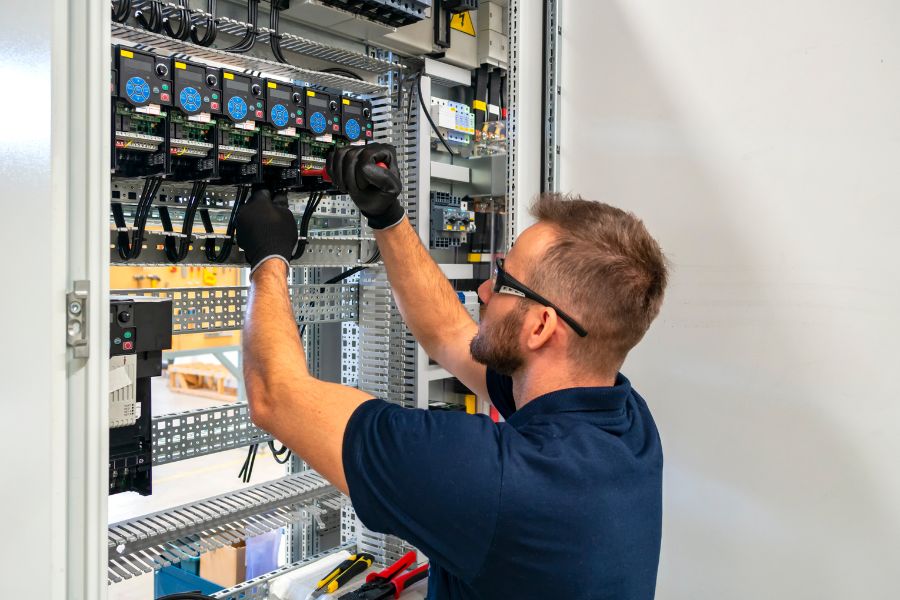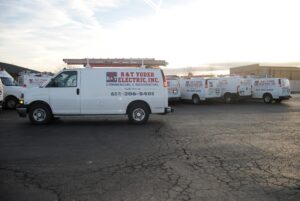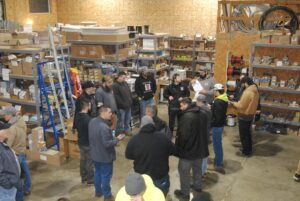
Your home’s electrical system operates like a well-rehearsed orchestra, and the breaker box is the conductor. Every flick of a switch, every charged device, and every appliance humming in the background depends on this unsung hero. Yet, when the breaker box falters, the symphony quickly turns into a chaotic mess of flickering lights, tripped circuits, and potential hazards.
Breaker box repair isn’t merely about restoring power; it’s about safeguarding your home from electrical failures, inefficiency, and fire risks. Understanding the warning signs, the repair process, and the benefits of professional intervention can save you from costly damages and ensure uninterrupted, safe power distribution throughout your home.
Why Timely Breaker Box Repair Is Essential
A malfunctioning breaker box is like a cracked dam—it might hold for a while, but eventually, it will give way. Ignoring minor electrical issues can escalate into full-blown system failures, damaging appliances and endangering your household.
Key Reasons to Prioritize Breaker Box Repairs:
- Prevent Electrical Fires:
Faulty wiring or damaged breakers can cause electrical arcing, a common culprit behind residential fires. - Ensure Continuous Power Supply:
Unreliable breaker boxes lead to intermittent power loss, disrupting daily activities and potentially damaging sensitive electronics. - Protect Appliances and Electronics:
Power surges stemming from faulty panels can shorten the lifespan of household devices. - Maintain Electrical Code Compliance:
Building codes evolve to enhance safety. Repairs ensure your system remains compliant, particularly during home inspections or renovations. - Avoid Costly Replacements:
Small, proactive repairs can prevent the need for complete panel replacements.
Did You Know?
According to the National Fire Protection Association (NFPA), electrical malfunctions cause over 46,000 house fires annually in the U.S. alone.
Common Signs Your Breaker Box Needs Repair
The breaker box doesn’t often announce its problems with a dramatic spark. Instead, it whispers through subtle signs that many homeowners overlook. Recognizing these symptoms early can prevent bigger issues down the line.
1. Frequent Circuit Breaker Trips
Circuit breakers are designed to trip when electrical flow exceeds safe levels. However, if your breakers trip repeatedly—especially when using standard appliances—your box likely needs attention.
Possible Causes:
- Overloaded circuits
- Worn-out breakers
- Internal wiring damage
2. Burning Smell Near the Panel
A faint, acrid odor near the breaker box indicates overheating wires or components. Heat buildup can melt insulation, exposing live wires and significantly increasing fire risks.
Immediate Action:
- Turn off the power supply.
- Contact an electrician immediately.
3. Flickering or Dimming Lights
When lights flicker without an obvious cause—like storms or loose bulbs—it often points to panel issues. As demand fluctuates, the panel might struggle to distribute power effectively.
Common Culprits:
- Loose connections
- Aging breakers
- Insufficient amperage capacity
4. Unusual Noises (Buzzing or Crackling)
Electricity should flow silently. If you hear buzzing, crackling, or sizzling from your panel, it suggests arcing—a phenomenon where electricity jumps between connections.
Fun Fact:
Arcing can reach temperatures of up to 35,000°F, hotter than the surface of the sun.
5. Visible Wear and Tear
Rust, discoloration, or scorch marks on the panel or breakers indicate internal damage. Corrosion weakens connections, reducing the system’s efficiency and safety.
Breaker Box Repair Process: Step-by-Step Breakdown
Breaker box repair isn’t a task for the untrained. It requires precision, specialized tools, and adherence to strict safety protocols. Here’s a glimpse into the repair process:
1. Power Shutdown and Safety Check
- Disconnect the main power supply to prevent accidental shocks.
- Use multimeters to confirm the absence of live current.
2. Panel Inspection
- Open the panel to inspect wiring, breakers, and bus bars.
- Identify signs of damage like burnt wires, corroded terminals, or loose connections.
Pro Tip: Burnt wire insulation often signals overloads or short circuits.
3. Repair or Replace Components
- Tighten or replace damaged wires.
- Install new breakers if the old ones fail to reset or trip as required.
- Clean and recalibrate connections for optimal performance.
4. Testing and Calibration
- Restore power and test each circuit individually.
- Use infrared thermometers to detect hotspots that could indicate hidden wiring issues.
5. Final Safety Inspection
- Conduct a comprehensive inspection to ensure compliance with the NEC and local codes.
- Label circuits clearly to aid future maintenance or troubleshooting efforts.
Breaker Box Components: What Goes Wrong and Why
Understanding the core components of a breaker box can demystify why repairs are sometimes necessary.
Key Components and Their Common Issues:
- Circuit Breakers:
- Function: Interrupt current flow during overloads or short circuits.
- Common Issues: Breakers that won’t stay reset or trip prematurely.
- Bus Bars:
- Function: Distribute power to individual circuits.
- Common Issues: Corrosion or warping due to excessive heat.
- Wiring:
- Function: Transport electricity between the panel and circuits.
- Common Issues: Loose, frayed, or rodent-damaged wiring.
- Main Breaker:
- Function: Controls power flow to the entire home.
- Common Issues: Mechanical wear, causing the breaker to trip under normal conditions.
Breaker Box Repair vs. Replacement: Making the Right Call
Not all breaker box problems require a complete panel replacement. However, some situations demand more than a quick fix.
Repair Is Suitable When:
- Breakers trip occasionally but not persistently.
- Minor wiring issues or loose connections are detected.
- The panel is relatively new and code-compliant.
Replacement Is Necessary When:
- The panel is over 25 years old.
- Circuit breakers trip frequently despite repairs.
- The box shows visible damage like scorch marks or rust.
- You’re adding high-demand appliances like EV chargers or hot tubs.
Example:
If your home still uses a fuse-based panel, it’s time to replace it. Fuses lack modern safety features, making them a liability in contemporary households.
The Hidden Dangers of DIY Breaker Box Repairs
Breaker box repair isn’t a DIY-friendly task. Despite the plethora of online tutorials promising quick fixes, the risks far outweigh the potential savings.
Risks of Unprofessional Repairs:
- Electrocution: Residential circuits carry lethal voltages.
- Fire Hazards: Incorrect wiring can cause overheating and arcing.
- Code Violations: Unlicensed work often fails inspections and voids insurance policies.
Fact:
In many jurisdictions, only licensed electricians can legally service breaker boxes.
Upgrading Your Breaker Box for Future Demands
Our homes are more power-hungry than ever. From electric vehicles to smart appliances, modern lifestyles demand robust electrical infrastructures.
Reasons to Consider an Upgrade:
- Increased Household Appliances: More devices mean more circuits.
- Renewable Energy Integration: Solar panel systems often require updated panels.
- Home Expansion: New rooms or additions demand expanded capacity.
Pro Insight:
A 200-amp panel is now the standard for most single-family homes, providing ample capacity for current and future needs.
Maintenance Tips to Extend Breaker Box Lifespan
Routine maintenance can significantly extend the lifespan of your breaker box.
Best Practices:
- Inspect Annually: Look for corrosion, discoloration, or buzzing sounds.
- Test Breakers: Trip and reset breakers every 6-12 months.
- Avoid Overloads: Distribute power-intensive devices across multiple circuits.
- Hire Professionals: Schedule regular inspections from licensed electricians.
Did You Know?
Dust accumulation inside breaker boxes can cause overheating. Keeping the panel area clean improves performance and safety.
FAQ Section
1. How do I know if my breaker box needs repair?
Frequent breaker trips, flickering lights, burning smells, and buzzing sounds are key indicators.
2. Can a faulty breaker box damage my appliances?
Yes. Power surges from malfunctioning panels can fry sensitive electronics.
3. How long does breaker box repair take?
Most repairs take 2-4 hours, depending on the complexity of the issue.
4. Is it possible to upgrade my panel during a repair?
Absolutely. If your panel is outdated or nearing capacity, upgrading during repairs is efficient and cost-effective.
5. How often should I have my breaker box inspected?
Professionals recommend inspections every 3-5 years or whenever adding new appliances.
Your breaker box is the command center of your home’s electrical system. When it falters, the consequences range from minor inconveniences to catastrophic damage. Don’t let flickering lights, tripped circuits, or buzzing panels disrupt your daily life.
Our team of certified electricians specializes in diagnosing, repairing, and upgrading breaker boxes with precision and care. We ensure code compliance, safety, and long-term reliability—because peace of mind starts with a well-maintained electrical system.







